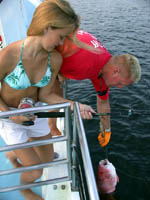
|
Features
|
|
|
|
Books
|
|
|
|
Fun & Games
|
|
|
|
Contact Us
|
|
|
John's Journal... Entry 232, Day 2
SNAPPER BONANZA
The Problem With Raising Captive Red Snapper: Producing Food For the Fry
 Editor's
Note: Dr. Ron Phelps, associate professor of the Department of Fisheries
and Allied Aqua Culture at Auburn University in Auburn, Alabama, works
in the area of fish reproduction. Phelps has been in charge of the snapper-research
project since 1995.
Editor's
Note: Dr. Ron Phelps, associate professor of the Department of Fisheries
and Allied Aqua Culture at Auburn University in Auburn, Alabama, works
in the area of fish reproduction. Phelps has been in charge of the snapper-research
project since 1995.
The snapper the researchers spawn start their lives at about 1/12-inch-long and must have food to eat within that first three days, or they'll die. The biggest breakthrough in the snapper research came when Dr. Ron Phelps, a fisheries scientist at Auburn University in Auburn, Alabama, and his team kept red snapper larvae alive past three days. "Copepods are the food source that snapper need once they hatch out of their eggs to survive," Phelps says. "These small crustaceans, which are basically baby zooplankton, are the most-abundant marine population in the Gulf. We had to learn how to raise the copepods and produce them in the size and the number that the snapper could eat when they first hatched. Then we had to learn to grow the copepods in an outside pond, trap and catch them. We needed 10- to 20- million copepods per day to feed one- to two-million just-hatched red snapper."
 When
the researchers put the copepods in the water for the baby snapper, a
large percentage of the copepods died off due to the raising of the copepods
at a lesser salinity than the baby snapper. However, with the new pipeline
bringing high-salinity salt water to the Mariculture Center, scientists
can raise copepods and snapper at the same salinity and release the baby
snapper in the ponds with the copepods, instead of having to bring the
copepods to the baby snapper. With the more-abundant supply of copepods
in the pond, scientists expect to have a higher rate of survival of the
young snapper. However, as Phelps explains, "fish science isn't perfect.
Sometimes, for an unknown reason, there will be no survival of the young
snapper that are spawned." The scientists use this artificial habitat
to trick the snapper into believing that they're going through all the
changes, light, temperature and moon phases they will experience in a
year. However, they cause all those changes to happen in this artificial
habitat in a 6-month period. Because the researchers control all the natural
conditions, the snapper thinks the time to spawn has arrived. By keeping
male and female snapper in the artificial habitat, when the females produce
eggs and get ready to spawn, the male has sperm also ready to fertilize
the eggs.
When
the researchers put the copepods in the water for the baby snapper, a
large percentage of the copepods died off due to the raising of the copepods
at a lesser salinity than the baby snapper. However, with the new pipeline
bringing high-salinity salt water to the Mariculture Center, scientists
can raise copepods and snapper at the same salinity and release the baby
snapper in the ponds with the copepods, instead of having to bring the
copepods to the baby snapper. With the more-abundant supply of copepods
in the pond, scientists expect to have a higher rate of survival of the
young snapper. However, as Phelps explains, "fish science isn't perfect.
Sometimes, for an unknown reason, there will be no survival of the young
snapper that are spawned." The scientists use this artificial habitat
to trick the snapper into believing that they're going through all the
changes, light, temperature and moon phases they will experience in a
year. However, they cause all those changes to happen in this artificial
habitat in a 6-month period. Because the researchers control all the natural
conditions, the snapper thinks the time to spawn has arrived. By keeping
male and female snapper in the artificial habitat, when the females produce
eggs and get ready to spawn, the male has sperm also ready to fertilize
the eggs.
To learn more about this program at the Marine Resources Division, e-mail Minton at rvminton@gulftel.com, and you also can visit www.dcnr.state.al.us/mr/cpmc.htm on the Web.
TOMORROW: TWO WAYS TO SPAWN SNAPPER: ARTIFICIALLY AND BY CREATING HABITAT
Check back each day this week for more about SNAPPER BONANZA ...
Day 1 - The Future Has Arrived
Day 2 - The Problem With Raising Captive
Red Snapper: Producing Food For the Fry
Day 3 - Two Ways To Spawn Snapper: Artificially
and By Creating Habitat
Day 4 - The Future of Red Snapper
Day 5 - Snapper As An Aquaculture Fish